8 | Seasonal
Dress your characters for the seasons! We’ll start with spring, which means light and bright colors that reflect the new life popping up all around, and layers to deal with the frequent weather changes. In summer, we bust out bold patterns in saturated colors and high contrast, as well as light fabrics to help survive the heat. For autumn, you can take a lot of your coloring cues from the trees—browns, reds, oranges, yellows and other desaturated earth tones. Your characters will probably need a heavy coat in preparation for winter. Winter coloring is all over the color wheel, but tends toward darker and more saturated. At this time of year, rely on accessories to brighten up outfits because heavy outer clothes can get reused to the point of looking dull.

Rain
Spring showers can catch everyone unaware once in a while. Here’s a brief guide to drawing your characters and their clothes after they’ve been stuck in the rain.
DRAW RAINDROPS

1Start with a generic teardrop shape. The longer tail conveys a speedy descent.
2When a raindrop collides with something, it splashes out into multiple drops.
3To convey the rain from a distance, draw random lines instead of individual drops. The more lines, the heavier the rain! It doesn’t have to fall straight down. If there are heavy winds, rain will slant.

FRIZZY HAIR
Frizzy hair on a humid day is a nice detail to help convey the season.
DRAW WET HAIR AND CLOTHES
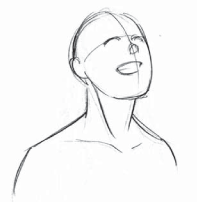
1Start with the basic head sketch.
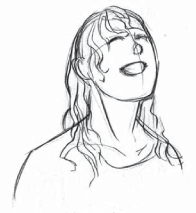
2Normally, you draw the hair a bit away from the head to convey volume, especially if it’s curly or wavy. When it’s matted down with water, it will stick much closer to the skull and gather into clumps that stick to the skin.

3Draw the wet clothing creases. Thinner fabrics, when soaked, will stick to the body in clumps as well and the creases between them are more random.

4For the full effect of soaked hair and clothes, draw a little halo of splashing water around the body and water onto the skin. Water on the face and neck won’t flow in straight lines, so take the contours of the face into account.
Spring Looks
Spring is here! Time to bust out the shorts, light dresses and sheer fabrics. Spring colors are warm and bright. To get inspiration for your outfits, imagine the bright colors of spring flowers and new, green foliage.

CHANGING WEATHER
Spring and autumn have a lot of clothing diversity because days can be cool or warm, or both! Wearing stockings, jackets, shrugs or going sleeveless all make perfect sense when the weather can go from chilly to sweltering to cool again.
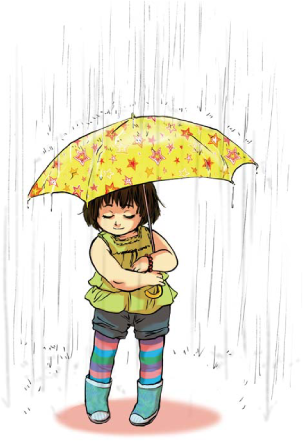
Open-Toe Shoes
Sandals are popular in the spring and summer and can have plenty of style and flair suitable for going out. Drawing sandals is not much different than drawing regular shoes, you just need to define the foot instead of covering it up.


Swimwear
You can’t talk summer fashion without swimwear. Bathing suits come in a massive variety of colors, patterns, shapes and cuts. Designers go out of their way to make the relatively simple concept of comfortable swimwear into an art form of its own. They can be simple, modest, gutsy, bright, ribboned or bedazzled.
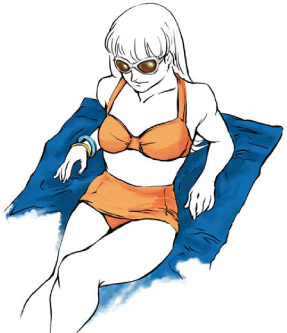

Summer Looks
Summer clothes call for thin, airy fabrics to let a breeze in and light colors to keep cool. Everyone breaks out their shorts and cotton T-shirts to try to beat the heat. Summer is also the time for brighter, bolder looks. Your characters that love attention look great in high contrast patterns and saturated colors.

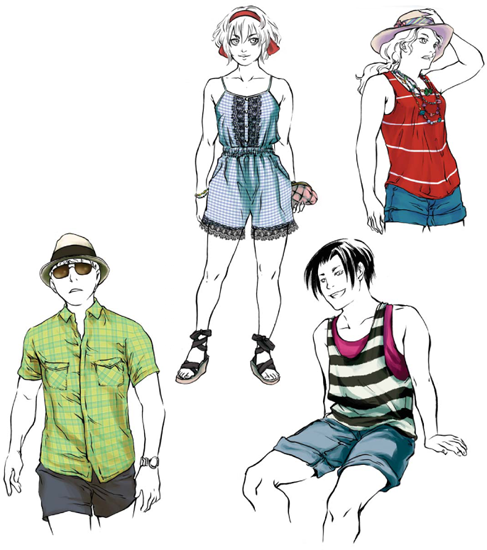
Sunglasses
Sunglasses are the quintessential summer accessory. They can be brightly colored, wild, weird, fun, sexy, simple or any combination thereof.

Autumn and Winter Looks
Autumn and winter clothing styles often overlap, depending on where your character lives. Up north, autumn can be much colder than winter in the south. People tend to break out their scarves and gloves when the weather turns chilly, and their heavy coats when it turns freezing.


Cold Weather Poses
In addition to a heavy coat, how a character carries himself is a good way to suggest the cold. Is he bent over, arms crossed, head down, shuffling forward or walking with gloved hands pressed to his mouth? Must be pretty cold!
CHILLY WEATHER
Here we have no more than a gently blowing breeze. Enough to stir a few hairs, but not move a heavy scarf. This is pretty typical weather for a chilly day, so the character is OK.

DRAW A WIND-BLOWN CHARACTER
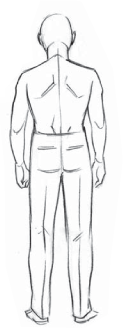
1The cold causes us to curl up. Sketch out the pose before adding clothing.

2 The coat is pressed close to the body on one side, and blowing away on the other. The scarf and hair are completely in the wind.
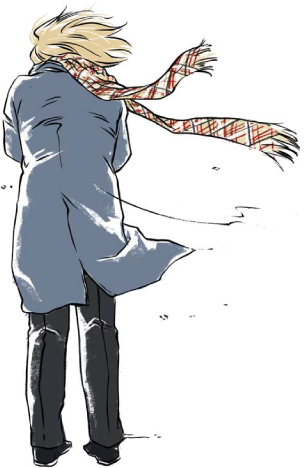
3 Because he is bending forward, there are stretch marks across the backs where the fabric is pulling, and another big fold where it is lifting off in the wind. Remember that because clothing is tailored, it can’t flap as freely as, say, a scarf. Add some lines in the air for wind and a bit of snow.
Padded Fabric
Puffy outerwear is a popular way to keep warm, and it’s cheaper to purchase than thick woolen coats or fur-lined leather. These coats come in any color, but people tend to buy them in neutrals because they wear them almost every day in the winter months.
DRAW A PADDED COAT

1Sketch the body. Keep the form tight to ward off the cold.

2Outline the clothing. Note that the big coat makes him look a lot thicker than he is.
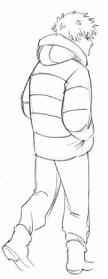
3Clean up the outline. Create wrinkles that pinch around the seams of the padded coat. Add some dark lines to convey depth, but not too thick or the coat will look flat.

4When colored, the inked seam lines disappear though their shape is still conveyed. The shading is flat and two-toned, because this fabric isn’t prone to shine.
DRAW A PADDED SLEEVE
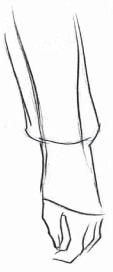
1Sketch the padded surface of the jacket over the arm. The outline will come up away from the arm. The stretchy, cuff fabric should hug the skin.

2Draw the stitching lines of the cuff and sleeve.
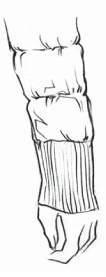
3 Clean up the outline. Pinch the seams and add a few wrinkles around them.
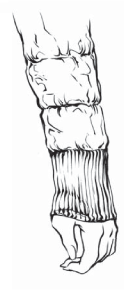
4The darker lines in the seams convey the depth of the padded, stuffed fabric. Add a few wrinkles in the middle of each fabric segment but keep the focus on the seams. Long, straight lights with a few straight creases will do for the cuff.
Knits
Knit clothing is the perfect look for autumn and winter. They have a lot of visible texture, and often the pattern changes within a single garment.

To draw a knit collar, start with a basic sweater collar and add horizontal curved lines along the neckline.
HERRINGBONE PATTERN

1 Make a vertical line to act as a guide and etch it with V-shapes. You can draw individual Vs or lines that run crosswise and intersect.
2 Repeat the Vs on the knit pattern. You might find it easier to do all the lines going one direction first, and then all of the lines going the other way.
3 Ink the pattern with a brush pen to give the knit pattern more depth.
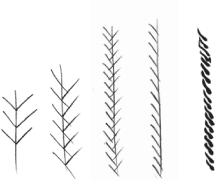
Apply knit patterns sparsely to a garment just so you get the idea that it’s knitted. Here the pattern is applied in the heavy shadows and fabric folds.
VERTICAL KNIT PATTERN

1 Knitting comes in all kinds of patterns, but to create that generic knitted look, make rows of short lines that are slightly curved.

2 Use a brush pen to vary the weight of the strokes, increasing depth and shadow. Create rows of “stitches,” keeping the lines fairly uniform.

3 Skip spaces to show the presence of texture without actually filling up the entire garment, which makes it darker and flatter.

The squares of a knit blanket are knitted separately, then linked together so that the different directions of the stitching create a pattern.

A bunch of short lines suggest a tighter weave.
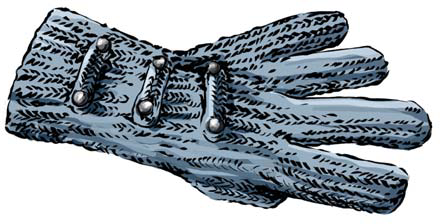
For really sheer fabrics, don’t use black outlines. It will make them look heavy and weighed down. Here, brown lines give this torn sweater a nice shabby look.
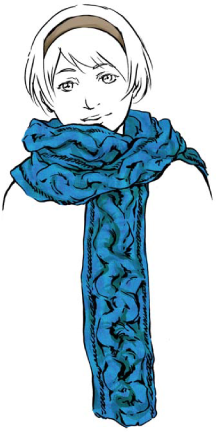

This big, cozy scarf has just a hint of knitting around the edges. Add shadows to enhance the bulging shapes so the scarf doesn’t appear flat.
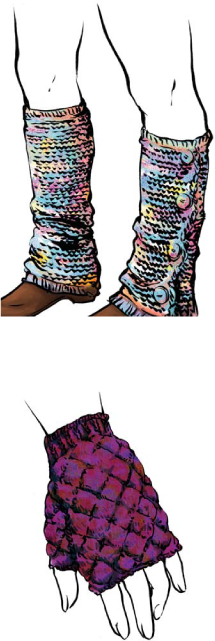
horizontal curved lines vertical curved lines herringbone
COMBINING KNIT PATTERNS
Sketch an outline of the pattern, then fill it with the knit patterns. When coloring, create realistic texture by adding knit patterns in the shadows and highlights.